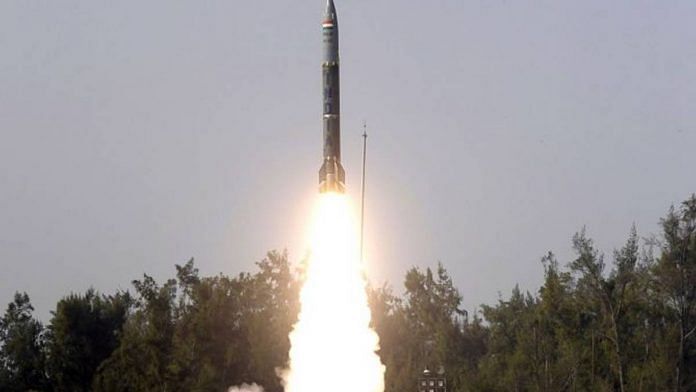New Delhi: The decision by the Defence Ministry to procure indigenous short-range ballistic surface-to-surface (SRBM) missile Pralay, a conventional weapon that has become ready for induction in just seven years, gives Indian military the heft to its war-fighting capabilities.
The missile will be India’s first tactical quasi-ballistic missile and will give the armed forces the capability to hit enemy positions and key installations in actual battlefield areas.
Pralay, along with the BrahMos supersonic cruise missile, will form the crux of India’s planned Rocket Force — a concept that was envisaged by former Chief of Defence Staff (CDS), the late General Bipin Rawat.
Sources in the defence establishment made it clear that only conventional missiles would come under the planned Rocket Force as and when it’s ready, while nuclear weapons would continue to be under the ambit of the Strategic Forces Command.
The Pralay missile project was sanctioned in 2015 and is a derivative of the Prahaar missile programme, which was first tested in 2011.
Sources said Pralay was formed through elements from multiple missile programmes that include the K-series of submarine-launched ballistic missiles and the ballistic defence shield programme.
The canisterised Pralay missile, with a range of 150-500 kilometres, has been developed according to the specifications and requirement of the Army, which was looking to arm itself with a tactical conventional missile that could be used on the battlefield.
Incidentally, both China and Pakistan have tactical ballistic missiles.
Also read: India’s missile test alert got Chinese research vessel to change course. Now it’s back
What makes Pralay deadly
The Indian missile can be compared to China’s Dong Feng 12 and the Russian Iskander missile that has been used in the ongoing war with Ukraine.
The US Army is in the process of increasing the range of a similar short-range ballistic missile called the Precision Strike Missile (PrSM).
What makes Pralay deadly is that it is a quasi-ballistic weapon, which means that while it has a low trajectory and is largely ballistic, it can manoeuvre in flight.
It has been designed to evade interceptor missiles, sources in the defence establishment said.
Ballistic missiles are initially powered by a rocket or series of rockets in stages, but then follow an unpowered trajectory that arches upwards before descending to reach its intended target at high speed.
Unlike intercontinental ballistic missiles that exit the Earth’s atmosphere, short-range ballistic missiles stay within it.
Sources added that Pralay would eventually be part of the Rocket Force, which will also include the BrahMos as well as the Smerch and indigenous Pinaka multi-barrel missile launchers, besides a few other systems that are being built.
Pralay is powered with a solid propellant rocket motor and multiple new technologies and, according to sources, accuracy is a highlight of this missile.
It is capable of carrying a conventional warhead of about 350 kg to 700 kg, which gives it a deadly punitive capability.
It can carry a high explosive preformed fragmentation warhead, penetration-cum-blast (PCB) and runaway denial penetration submunition (RDPS).
Asked what was the need for a ballistic missile when there is already a cruise missile whose range can be shortened for use in a battlefield, sources explained that both have their own distinct advantages.
While BrahMos has high agility, stealth and even loitering capability, Pralay has the advantage of speed and countering it is a difficult task, even for modern air defence systems.
(Edited by Nida Fatima Siddiqui)
Also read: Ramjet technology can counter China’s long-range missiles, beat Himalayan terrain limitation



